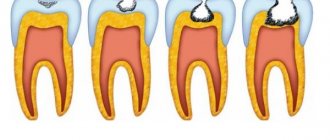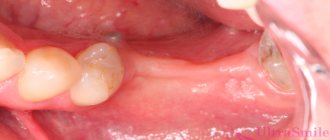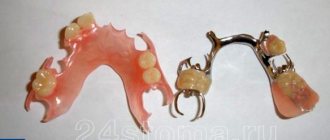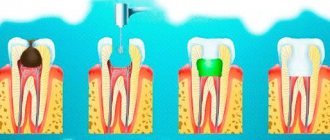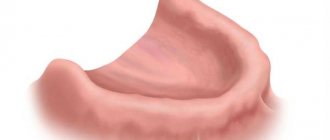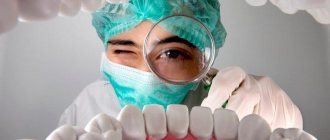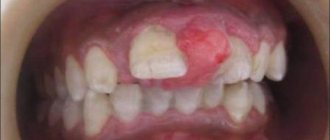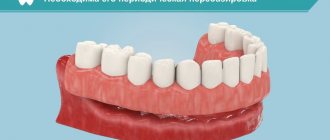When is classification needed?
Any of the classification methods makes it easier for the orthodontist to study partial tooth loss, simplifies documentation, and allows doctors to identify the problem during work. However, the widespread classification is not able to provide guidance on the choice of design and cannot reflect a specific picture of disorders, type of occlusion, or tissue health.
Thanks to systematization, the definition of a defect is accelerated, clarified, and the choice of treatment direction is clarified. If you do not take into account the nature of the pathology, you can harm the functionality of your teeth with improper prosthetics.
Then the loads are distributed unevenly, tissues and teeth are overloaded, causing complications. To exclude the development of events, orthodontists systematized pathologies, dividing them into classes and subclasses.
Parameters that allow you to assign a defect to a specific group:
- defects in the structure of the jaw units coming after the canines,
- structural anomalies of incisors, canines,
- pathology of the posterior or anterior part of the arch,
- problems with the outermost teeth of the row.
The most common types of systematization are according to Betelman, Kennedy, Gavrilov. Named after the names of the inventors. Not very popular methods - according to Zhulev, Eichner, Oksman.
Classification according to Gavrilov
Evgeny Ivanovich Gavrilov is a Doctor of Medical Sciences of the USSR, who developed a system for classifying defects in rows of teeth. He set himself the task of achieving the restoration of the functionality of the teeth and the correct load on the parts of the dentition. Gavrilov's system includes the following defects:
- Defects of the anterior teeth;
- Bilateral and unilateral dentitions with problems at their ends;
- Almost completely edentulous;
- Double-sided and single-sided rows with side defects;
- Combined version of defects.
Kennedy classification
American dentist Edward Kennedy was a revolutionary in performing operations designed to eliminate malocclusion. The accumulated experience allowed him in 1921 to develop a classification of the anomalies encountered, identifying 4 classes and 3 subclasses:
- 1 class. Absence of chewing teeth on both sides of the arch. Subclasses distinguish 3 options for the development of the situation. The first - in addition to the absence of molars, one more tooth is missing. Second – molars and teeth are missing in 2 places. The third – apart from the molars, there are no teeth in 3 different places. The main method of treating anomalies of this group is devices with labile fastening,
- 2nd grade. Unilateral defect, loss of distal support. There are 3 subclasses, similar to the previous one. Correction of such defects is carried out with prostheses with palatal fixation (on the side of healthy teeth) and a device with labile fastening (in the area with the defect),
- 3rd grade. Unilateral problem, presence of distal support. The subclasses are the same as above. The optimal prosthesis is a bridge-like removable structure, which is secured with clasps,
- 4th grade. These include clinical situations where the patient does not have front teeth. The problem is eliminated by installing a prosthesis with support clasps.
Classification of dentition defects according to Betelman
To make a correct diagnosis and draw up a treatment plan, the orthopedic dentist uses the Betelman or Kennedy classification of dentition defects. The Betelmann classification of dentition was developed in the 1930s. A few years later, Doctor of Medical Sciences, Professor Abram Isakovich Betelman published the book “Orthopedic Dentistry” where this classification was posted.
In his classification, Betelman identified 2 classes and 2 subclasses:
Betelmann class 1 : dentitions that have one or more terminal defects
- 1 subclass : unilateral terminal defect of the dental arch (left-sided or right-sided). The defect must be located on one side of the jaw! Similar to Kennedy class 2.
- Subclass 2 : bilateral terminal defect of the dentition. The defect must be located on both sides of the jaw. Analogous to Kennedy class 1.
Betelman class 2 : dentitions that have included defects - one or more. Defects limited to teeth!
- 1st subclass : one or more defects of the jaw dentition with a length of up to 3 teeth each.
- Subclass 2 with: one or more defects in the dentition of the jaw with a length of more than 3 teeth each.
According to the Kennedy classification, the length of the dentition defect does not matter! This classification applies to both the upper and lower jaws!
When different classes of defects are combined, the diagnosis is biased in favor of the smaller class. For example, if a patient can be found to have class 1 1 subclass and class 2 1 subclass, the diagnosis will be as follows: class 1 1 subclass.
Classification of dentition defects according to Betelman
| Betelman class 1, subclass 1: unilateral terminal defect of the dentition | Betelman class 1, subclass 2: bilateral terminal defect of the dentition |
| 2 class 1 subclass according to Betelman | 2 class 2 subclass according to Betelman |
zubodont.ru
Gavrilov system
E.I. Gavrilov is a Doctor of Medical Sciences, a prominent scientific figure of the Soviet Union. His goal was not only to restore aesthetics to the dentition, but also to restore functionality and distribute the load over all areas of the jaw. The systematization developed by Gavrilov defines a detailed description of the problem, which helps the doctor determine a treatment regimen. The scientist systematized the problems into 7 groups.
Do you feel nervous before visiting the dentist?YesNo
I class. This includes defects on the right and left sides of the end of the dental arch.
Treatment options:
- clasp denture with cast clasps gently acts on the teeth that serve as support,
- removable partial plate denture. There are disadvantages - weak fixation, the likelihood of tipping over while eating due to one-sided load,
- prosthetics with implants - a fixed prosthesis that restores the functionality of the jaws without stress. If there are no contraindications, then this option is considered the best.
II class. This group includes defects when the distal support of one of the jaws is lost. Prosthetic options are selected similarly to the conditions. The bilateral presence of problems at the ends of the jaws ensures fixation of the removable denture, the load is evenly distributed along the row. When choosing designs, they choose a clasp denture when it comes to problems of the upper jaw. Thanks to the metal arc, it is possible to reduce the dimensions of the plate, and the sky remains open.
For conditions belonging to this group, you can choose fixed prosthetics. This method of restoring the functionality of the jaw is acceptable when installing implants. For situations where teeth have long been lost and there has been no treatment, bone deficiency becomes a sign. Technologies make it possible to carry out an operation to increase it. If there are no contraindications and hygiene skills are satisfactory, then prosthetics with implants will be an effective solution to the problem than removable structures.
III class. This group includes defects accompanied by the absence of molars, provided that the extreme molar is preserved.
The dentition can be restored with removable, fixed dentures of the following types:
- removable clasp prosthesis. A good option, but not comfortable. The disadvantages are due to the fact that the structure is removed, and with a one-sided effect it overturns,
- a bridge-like structure, one of the supports of which is fixed on the chewing tooth. This is an inexpensive prosthetic option. The advantages of the method include the reliability of fixation, the disadvantages are the load on the supports. Contraindications to choosing a bridge include periodontal disease, mobility of teeth,
- Implantation occupies a leading position. This method provides maximum comfort and physiology identical to natural. The load on the supporting teeth is eliminated, healthy tissues do not need to be ground down, but chewing and aesthetic functions are completely restored.
IV class. This group includes conditions when the side sections have flaws, but the distal supports are preserved. Options for eliminating the problem are similar to those indicated above, but clasp dentures no longer have any disadvantages, since here the load is evenly distributed over all teeth.
V class. Includes conditions in which several units are missing from the front of the soul. Bridges and removable dentures will help restore the dentition. To ensure reliable fixation, clasps are used. Such fastenings are noticeable on the teeth, so the aesthetics will not be up to par. Considering that we are talking about teeth involved in a smile, this method of treatment should not be preferred. Bridges, if they have strong supports, provide excellent functionality, but they look unsightly, especially if there is a gap between the gum and the neck of the artificial crown.
Unlike previous treatment methods, implants have virtually no disadvantages (except for price). They are able to restore lost aesthetics and chewing function. One-stage implantation becomes preferable, in which the tooth is removed and an artificial root is immediately installed in its place. This allows you to preserve the shape of the gums, the amount of jaw bone tissue, and creates optimal conditions for wound healing. The result obtained in terms of aesthetic indicators has no equal.
VI grade. This includes combined defects. Planning is carried out taking into account the identified problems.
VII class. The last group includes all pathologies in which there is only one tooth left in the mouth.
Systematization according to Gavrilov is used by orthodontists; it allows choosing the optimal design for prosthetics in a wide variety of conditions. Then single teeth were used as support for removable dentures. This practice was widespread in relation to problems of the lower jaw.
Thanks to implantation, there is no longer a need to save a tooth if there is little reason to do so. Implants can become a support for various orthodontic structures in the presence of single teeth or complete edentia.
Classifications of tooth position anomalies in orthodontics
Classifications in orthodontics are of utmost importance, since the number and variety of anomalies of the dental system are very large. Systematization of bite pathologies allows us to express the essence of a particular disease in a concise and accessible form. It is required for a unified record of deviations from the norm, their ordering, determination of the treatment method and the convenience of international discussions.
Varieties
Attempts to systematize various types of malocclusions and isolate them into separate pathologies were made at the dawn of orthodontics.
There are many systems of dental anomalies and deformations, as well as methods for diagnosing them.
At the beginning of the 18th century, a treatise by Pierre Fauchard was published describing the reasons for the incorrect position of teeth and methods for correcting occlusion, mainly through metal arches.
Interesting!
The first systems were based on the principles of the correct or incorrect position of the teeth and reflected the now outdated methods, which were reduced only to straightening individual dental units. An example of this is the Kneisel system, created in 1836 and described in detail by him in the book “Crooked Teeth.”
A little later, towards the end of the 19th century, other systems began to appear, but also based on the relationship between the position of the anterior areas of the dentition.
With the development of orthodontic science, data has accumulated on how and why anomalies in the position of teeth can occur, and what their types are. All this contributed to the fact that in their work doctors began to take into account not only the principles described above, but also the relationship between the position of the lateral teeth and their role in speech production in normal and malocclusion.
In 1842, Carabelli classified all types of bites, including normal and crossbite.
More than half a century later, in 1902, Sternfeld proposed to distinguish between physiological and pathological occlusion depending on the nature of the closure of the jaws.
His classification was successful and was recognized by most doctors: the designations introduced by Sternfeld: orthognathia, prognathia and progeny are still used today.
The concept of anomalies and their varieties is present in modern classifications, the authorship of which belongs to P. Simon, N. I. Agapov, A. Ya. Katz, D. A. Kalvelis, L. S. Persin and others.
Each country, and even almost every dental clinic, uses different systems, sometimes with its own additions. Some of them describe types of secondary deformations and are actively used for the diagnosis and treatment of oral diseases. Even if all the teeth are present, their pathological mobility and malocclusion in adulthood cannot be ruled out.
Angle's classification in orthodontics
The first system based on the principle of the relationship between the positions of rows of teeth was the classification of dentofacial anomalies according to Engle. Its key element was the determination of the mesiadistal relationships of the first molars above and below.
On a note!
The term "mesiadistal" when applied to teeth means: in the direction from the midline of the jaw to its edges.
It was the relative position of the first molars that Engle considered the “key of occlusion” and argued that the upper first molar always erupts in its place.
Its permanent location is determined by two factors: the fixed connection of the upper jaw with the bones of the skull and the presence of an anterior second molar.
This means that all anomalies in the shape and size of the “sixes” are caused exclusively by the atypical location of the lower jaw.
Pathological occlusion according to Angle is divided into:
- 1 – neutral bite;
- 2 – distal bite;
- 3 – mesial bite.
Skeletal class 1 is described by the normal contact of the rows of teeth in the areas where the first molars grow. The external cusp of the six of the upper jaw, facing the cheek, is located in the depression (fissure) between the buccal cusps of tooth No. 6 of the lower jaw. The pathological position in this case is localized on the frontal (chewing) surfaces of the teeth.
Angle's second class is distal displacement of teeth: the first molar is shifted from below. The external tubercle of the upper six from the side of the cheek stands on the same tubercle of the lower antagonist or comes between dental units No. 5 and No. 6. Pathologically changed positions concern the teeth of the entire jaw arch.
The second class is divided into:
- 1st subclass - the incisors of the upper jaw fan out to the sides and protrude forward;
- Subclass 2 - the upper incisors occupy an oral position, tightly compress with the lower ones and significantly cover them.
On a note!
The described disorders can be both symmetrical and asymmetrical due to a unilateral change in the relative position of the first molars.
The 3rd skeletal class is described by the mesial position of the teeth: the 1st molar at the bottom “goes” forward relative to the upper antagonist. The outer cusp of the upper six comes into contact with the cusp of the 1st lower molar or finds itself in the “passage” between dental units No. 6 and No. 7.
The lower incisors protrude and cover the upper ones. An anomaly in the dentition may be such that a gap forms between the lower and upper incisors. In severe cases, the position of the lateral teeth is pathologically changed, and the external cusps of the lower dental units overlap the upper cusps of the same name.
Engle's list also includes several types of anomalies in the position of individual teeth:
- buccal;
- lingual;
- front;
- rear;
- infraposition of the tooth;
- supraposition of the tooth;
- tortoanomaly.
Angle's system is very simple and has been the main one in orthodontic science for a long time. It has not lost its relevance to this day, although it has undergone a number of significant transformations. Its main disadvantage is the fallacy of the statement that the position of the first upper molar is always unchanged.
On a note!
If the second primary molars fall out or are removed prematurely, the new first molars grow closer to the middle, that is, they move in the mesial direction.
In his system, Engle takes into account the shift of the dentition only in the sagittal plane, while dentofacial deformations have a three-plane displacement.
According to Kalvelis
Kalvelis proposed dividing all types of deformations into 3 groups. Group 1 includes anomalies of individual teeth:
- by quantity - hypo- and hyperdontia;
- in shape and size - gigantic, spiky, ugly; teeth of Hutchinson, Fournier and Tourneur;
- by structure - enamel hypoplasia of rachitic, tetanic, dyspeptic, syphilitic, infectious origin;
- according to the time of appearance - premature or late eruption.
Group 2 includes deformations of the dentition:
- incorrect position of some teeth;
- trema and diastema;
- crowding;
- irregular shape of rows - narrowed, saddle-shaped, quadrangular, V-shaped and asymmetrical.
Group 3 – bite pathologies:
- longitudinal;
- transverse (transversal);
- vertical.
According to Persin
Persin's classification of orthodontics includes anomalies in the closure of the dentition and paired antagonist teeth. Malocclusion is divided into defects of the lateral areas:
- disocclusion;
- disocclusion;
- cross occlusion with lingual, cross and vestibular position of teeth;
and frontal areas:
- vertical and longitudinal disocclusion;
- vertical, longitudinal and cross violation of the closure of individual pairs of antagonist teeth.
According to WHO
The International Classification of Diseases of the World Health Organization (ICD 10) is in effect throughout the world and in Russia. Its experts, together with practicing dentists, have developed their own systematization of dental deformation. Some points in it are taken from the systems of Kavelis, Kalamkarov, Svenson and Gavrilov.
The WHO system consists of 5 types of anomalies:
- by jaw size – macro- and micrognathia, asymmetry;
- by the position of the jaws;
- according to the relationship of the jaws - distal, mesial, cross, deep and open bite;
- according to the configuration and size of the jaws - narrowed, flattened, enlarged and reduced jaws relative to the norm;
- defects of some teeth.
On a note!
The jaw arch can have an acute-angled shape, which is determined by the fangs: the jaw contracts precisely in the area of the third teeth.
MSMSU classification
The system developed at the Moscow University of Dentistry combines all anomalies into four groups:
- Group 1 includes defects of the teeth themselves;
- in the second - the dentition;
- in the third - jaws;
- in the fourth – bite.
Dental defects included in the first group are classified according to shape, size, color, structure and position. This also includes early and late teething.
Defects in the dentition mean a violation of their shape, length and width. This item also includes incorrect sequence, asymmetry, too sparse or dense growth of teeth.
Jaw defects are a violation of the shape, size, relative position of the jaws or their individual parts.
Bite defects include abnormal closure of the teeth at the front, sides, and cross.
Katz classification
Katz divided all malocclusions into three classes:
- Class 1 is described by the irregular relationship of the rows of teeth in the areas preceding the first molars;
- Class 2 corresponds to the distal position of the sixes of the lower jaw or the mesial position of the first molars of the upper jaw;
- Class 3 represents anomalies with a forward shift of the lower sixes relative to the upper ones.
Kalamkarov classification
Kalamkarov created a system where he took into account the proposals of Engle, Malygin and other authors. In it, he presented anomalies of teeth, jaws and combined bite pathologies.
Kalamkarov is convinced that the absence of teeth, supernumerary and unerupted teeth cannot be considered a problem of the dentition. Not all experts agree with this, since the lack of characteristics of dentition anomalies makes the classification of dentoalveolar types of defects more impoverished. Isolating congenital defects does not save the situation and does not bring clarity.
Bottom line
None of the existing classifications fully satisfies either science or practice. Orthodontic systems, as in most medical fields, cannot be static because they reflect a certain level of knowledge and experience. Systematization principles and terminology are subject to periodic revision, which is one of the sources for the development of scientific orthodontics.
Source: https://jsmiles.ru/ortodontiya/15-anomalii/257-klassifikacii-v-ortodontii/
Betelmann classification
Betelman developed a type of systematization that allows you to select a denture for dental problems. Its classification involves dividing deviations into 2 classes, each with 2 subclasses.
I class. They include conditions when end defects are detected (no molars, starting from the 5th or 6th unit to the end of the jaw). If the problems are localized on one side of the arch, they are classified as subclass I, if on both sides - to subclass II.
II class. This group of dental problems includes the absence of crowns anywhere in the dental arch. There are 2 subclasses:
- Conditions in which 1 or more included defects are detected, with one problem area including up to 3 missing units.
- The presence of 1 or more included defects, and the defect includes more than 3 missing units.
Clasp functions
The main purpose of clasp-type retainers is retention - holding the prosthesis in place during use. The clamps are a support that does not allow the structure to move in the direction of the mucosa; they counteract the force of lateral pressure and, to a small extent, the load along the vertical axis.
The shoulders contribute to the clamping of the support unit. Together, these functions ensure reliable fastening of the denture, which minimizes inconvenience during use and improves the quality of life.
Ney system
The methods were introduced into orthodontics by Ney in the middle of the last century. These are classic support-retaining clamps. They contain a process, two shoulder elements and an occlusal type overlay.
To minimize fastener fracture, the areas located closer to the base were made thicker and stronger, while the distant sections gradually became thinner, and the product took on the shape of a horn.
Ney devices include the following options:
- Single-armed.
- Forked Roach.
- Acker with two shoulders.
- Ring single-arm.
- Combined.
General characteristics include practicality, wear resistance, and high aesthetics.
Acker's clasp
One of the most effective and affordable fasteners. Installed on molars in the absence of one or more chewing elements and intact supports. Simple in design, it reliably keeps clasp dentures from moving.
The rigidity of the model’s frame can be considered both a plus and a relative minus, depending on the situation.
Various types of clasps
Zhulev classification
E.N. Zhulev is a professor, representative of the Medical Academy of N. Novgorod. Zhulev will present a systematization of dental problems in 1989. The essence comes down to the distribution of pathologies into 5 groups (classes):
- Pits, depressions, cavities in fissures.
- Pits on the incisors, cavities in the fissures.
- Cavities on the surface of the incisors and lateral teeth.
- Cavities in the gingival, cervical area.
- Combined anomalies, including the symptoms indicated above.
In addition to those listed, there are well-known systematizations of dentition defects, but they are used less frequently.
Types and classification
The variety of problems associated with tooth loss leads to the emergence of a large number of clasp designs and classifications.
According to the functions of the system there are:
- Abutment - used on molars and canines, require the use of locks, rarely used in isolation.
- Retaining - sometimes lead to sagging of the prosthesis.
- Combined, or support-retaining.
Depending on the choice of material, the clamps are:
- Metal (metal alloys).
- Acrylic (plastic).
This is what plastic clasps look like
: Types at the place of application:
- Gingival.
- For the dentition.
- Combined.
According to the type of element coverage: single-arm, double-arm, T-shaped, reversible, double, multi-link.
According to mobility of connection to the prosthesis:
- Movable.
- Tough.
- With springy effect.
By mounting configuration:
- Spot.
- Linear.
- Planar.
Clasps hold the prosthesis in place, preventing it from moving onto the mucous membrane
According to Kennedy and Gavrilov
II class according to Kennedy - 1 according to Gavrilov
Since there is no distal support, it is impossible to make a permanent bridge, there is simply nothing to fix it to. Previously proposed cantilever structures with an overhanging artificial crown did not stand the test of time. They do not last long and, in addition, lead to loosening and falling out of the support.
The following orthopedic treatment options are possible:
- partial plate removable denture is not fixed well enough and tips over during chewing, since the load falls on one side of the plate;
- The clasp prosthesis, due to the presence of cast clasps and a metal arch, tilts to a lesser extent and acts less aggressively on the supporting teeth;
- prosthetics on implants according to the principle of one tooth - one implant involves the manufacture of a non-removable structure. In this case, chewing efficiency is completely restored and there is no additional stress on the remaining teeth. In the absence of special contraindications, this is the method of choice.

